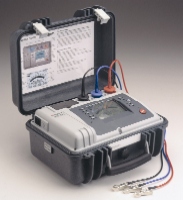Insulation Resistance Testing
The measurement of insulation resistance provides a reliable and convenient means of monitoring the condition and state of readiness of high-capital electrical equipment. All common electrical circuitry…whether wiring, cabling, control devices, motors, transformers, generators and the like…is surrounded by some type of insulating material.
![]() At time of manufacture, this material typically has enormous resistance, typically too high to even measure except with the highest quality testers. But when put into service, insulation begins to degrade from a variety of factors, and the decline in resistance values provides a reliable indication of the extent of this degradation, and by extension, of the expected life of the equipment.
At time of manufacture, this material typically has enormous resistance, typically too high to even measure except with the highest quality testers. But when put into service, insulation begins to degrade from a variety of factors, and the decline in resistance values provides a reliable indication of the extent of this degradation, and by extension, of the expected life of the equipment.

Megger Model# 1000-376 Catalog # MIT520/2 – 5 and 10-kV Insulation Resistance Testers Line supply or battery operated Digital/analog backlit display
Measuring the decline and rate of change of insulation values forms the basis for “preventive/predictive maintenance”, by which the equipment is periodically monitored. Items with sufficiently high resistance are not likely to fail in the near future, and so repeat testing can be delayed appropriately to save man-hours. Conversely, items exhibiting lower resistances can be trended by their rate of decline to indicate an optimum time to take out of service for restorative maintenance, in order that they not fail in service.
Failures can also occur catastrophically, as by flooding, lightning, and extreme voltage surges. These cannot be anticipated, but insulation testing is the first step in troubleshooting and repair, and can be used to monitor the restoration of failed equipment through drying and cleaning processes.

Megger Model# 1000-372 Catalog # MIT510/2 – 5 and 10-kV Insulation Resistance Testers Line supply or battery operated Digital/analog backlit display
Insulation testers require a special knowledge, of greater depth than most common electrical testers. Because they are applied to insulation, a non-conductor, readings are not as self-evident as with common measurements of circuitry and components. Rather, the test item charges during the course of an insulation measurement, causing readings to change constantly over the time of the test. If this is not fully understood, the test can be rendered completely ineffective. In addition, while insulation testers themselves, despite their high voltage outputs, are not inherently dangerous, a highly charged test item can be lethal. Therefore, the operation of the tester and the nature of the charging currents must be fully understood in order for insulation testing to be both effective and safe.
Standard test methods have been widely adopted in order to expedite test time, effectively deal with the changing readings over time, and specifically identify different problems. An understanding of these methods is indispensable to effective use of an insulation tester.

INSULATION RESISTANCE TESTER The BM15 and MJ15 are compact 5-kV insulation testers that are simple to use
Insulation responses to both testing and operational demands are influenced by extraneous factors such as temperature and humidity. Without proper understanding, these factors can cause misinterpretation of otherwise coherent results. Standing alone, an insulation reading of “x” Megohms can be meaningless or even misleading. When backed by proper knowledge, it is one of the most effective tools of electrical maintenance.
Latest posts by Mike Novello (see all)
- Used Bio-Rad Gel Doc XR For Sale - March 9, 2022
- CONSULTIX WTX-35-A4 CW Test Kit For Sale - November 9, 2021
- Biologic SP-150 Single Channel Potentiostat and VMP3B-80 Booster For Sale - September 7, 2021









